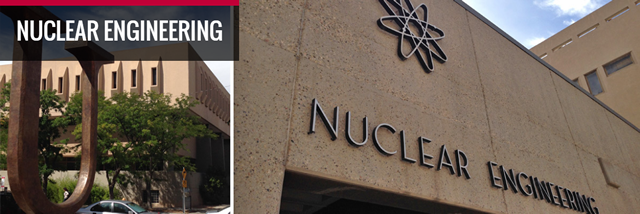
Nuclear Engineering ETDs
Publication Date
Spring 4-9-2018
Abstract
Modern ultraviolet (UV) cameras, when combined with UV-transmitting lenses/filter arrangements, can be used to detect radiation dose in air. Ionizing radiation excites nitrogen molecules in ambient air, the resulting decay includes weak emission of ultraviolet photons. Previous work has proven this phenomenon is detectable using highly-sensitive electronically cooled cameras traditionally used in astronomy for low-background imaging. While the ability to detect the presence of radiation (i.e. qualitative measurement) has been demonstrated at Sandia National Laboratories, there are several challenges in correlating images to known dose-fields (quantitative measurement). These challenges include: a low signal to background ratio, interferences due to electronic noise and direct radiation interactions with the camera, and a complex source-dependent detection efficiency. Based on measurements of low-level radioactive sources as well as high-level sources at several irradiation facilities at Sandia National Laboratories, researchers are developing deeper understanding of these challenges in an attempt to engineer a system that can be used for quantitatively measuring radiation dose fields remotely. This thesis will describe these efforts and share the lessons learned from several experiments.
Keywords
Optical Detection of Radiation, Nuclear Engineering, Radiation Detection
Sponsors
Defense Threat Reduction Agency
Document Type
Thesis
Language
English
Degree Name
Nuclear Engineering
Level of Degree
Masters
Department Name
Nuclear Engineering
First Committee Member (Chair)
Adam Hecht
Second Committee Member
Cassiano de Oliveira
Third Committee Member
Jeffrey Martin
Fourth Committee Member
Richard Harrison
Fifth Committee Member
Charles Potter
Recommended Citation
Fournier, Sean D.; Adam Hecht; Cassiano de Oliveira; Jeffrey B. Martin; Richard K. Harrison; and Charles Potter. "An exploration of the optical detection of ionizing radiation utilizing modern optics technology." (2018). https://digitalrepository.unm.edu/ne_etds/67
Included in
Atomic, Molecular and Optical Physics Commons, Electromagnetics and Photonics Commons, Nuclear Commons, Nuclear Engineering Commons, Optics Commons, Systems Engineering and Multidisciplinary Design Optimization Commons
